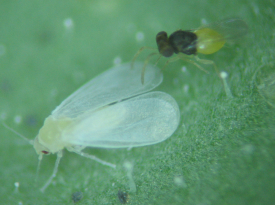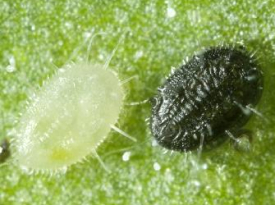- Track your orders
- Save your details for express checkout



Shopping
Mite-A for Thrips Control
Neoseiulus (formerly Amblyseius) cucumeris - Predatory mite
Supplied in bulk form or in slow release sachets (please contact us directly for a quote on sachets, large orders only)
Mite-A™ is a highly active predator of thrips, especially onion thrips, Thrips tabaci, Western flower trips, Frankliniella occidentalis, New Zealand flower thrips, Thrips obscuratus and other thrips species. Mite-A™will also eat twospotted spider mites, broad mites, cyclamen mites, European red mites and citrus red mites (Panonychus spp.) and other mite species.
Mite-A™ is known to be useful on greenhouse crops such as tomato, cucumber, pepper and ornamental plants as part of an integrated pest management programme.
BE PROACTIVE - Mite-A™ is best used in a preventative manner, applied early to the crop prior to the build up of thrips. Mite-A™ can survive and breed in the presence of pollen alone.
Mite-A™ is a small, highly active predatory mite and is pale in colour. Adult females are approximately 1.25 mm long.
Mite-A™ also feeds on other mites, such as mould mites, and on the eggs and early stages of twospotted spider mite.
Mite-A™ can use pollen as a food source which helps it survive under low prey conditions. Capsicums and other crops provide a ready pollen source, but if pollen is too plentiful, this can reduce the effectiveness this predator.
Mite-A™ is not considered harmful to humans and animals, and no environmental impacts are expected.


The pest: whitefly (left) & the solution: Encarsia (right)

Normal whitefly pupa (white) and parasitized pupa (black). An adult Encarsia will emerge from the black scale(right)
The Pest: Thrips
Thrips are small slender insects and adults about 1-1.5 mm long, with feathery wings. Their colour varies from pale yellow to light or dark brown. The immature stages (nymphs) look similar to adults but are smaller, paler in colour and lack wings.
Thrips have piercing-sucking mouth parts and feed by puncturing the surface of leaves, flowers and fruit. Both adults and nymphs cause damage.
Signs and symptoms of thrips include:
-
Yellow speckled or silvered appearance of leaves and fruit
-
Black spots of excrement on leaves
-
Small insects in the flowers or on the undersides of young leaves in your crop
Thrips may also be responsible for the transmission of some virus diseases.
Life Cycle
The life cycle begins with small white eggs that can be seen attached to leaf hairs along veins on the lower leaf surface. At 68 degrees F eggs hatch in about 3 days into nonfeeding larvae that molt to nymphs after about 2 days.
The 2 nymphal stages which last 7 days, as well as the adult stage which lasts up to 30 days feed on immature stages of thrips. The adult female can lay up to 35 eggs in her lifetime. Adults can eat an average of 1 thrips per day and also feed on two-spotted mites and their eggs.

Environmental Conditions
Optimum conditions for Mite-A™ are warm (20-25 °C), semi-shaded conditions with relative humidity greater than 65%. Plants planted close together or with dense foliage provide these conditions.
Packaging
Mite-A is supplied in either sachets or as a bulk mixture.
Sachets contain approximately 40 ml or 5 g of bran mixture with a minimum of 400 predatory mites per sachet, and mould mites which act as a source of food for the predators.
Neither Mite-A nor the mould mites damage living plants.
Application Rates
BEST USED FOR THE PREVENTION OF THRIPS
| Broadcast application | Outdoor crops | Minimum of 25 ml mite mixture per m2 sprinkled carefully on the leaves of the crop. |
|---|---|---|
| Greenhouse/Indoor crops | A repeat application 2 weeks later is recommended to ensure establishment | |
| High value or thrips susceptible crops benefit from weekly or fortnightly applications | ||
| Can provide some protection from two spotted mites (TSM) when TSM densities are low | ||
| To control broad mites and cyclamen mites (Steneotarsonemus pallidus) on strawberries, it is recommended to apply at least 1 Mite-A per 10 pest mites, around 1 litre per 25-50m2 | ||
| Sachet application | Greenhouse/Indoor crops | 500 sachets per 1000 square metres, or approximately 1 sachet per 4-5 plant stems. |
| Mite-A will emerge from the sachets over a period of 2-4 weeks. In capsicum, introductions of predators should be made every 6 weeks throughout the winter. In summer, one introduction should be sufficient at the time of first flower opening. |
Release and Storage Instructions
Mite-A is dispatched via courier and should reach you within 1 to 2 days.
Once received:
-
Do not expose to direct sunlight
-
Keep in darkness and in a cool environment - ideal temperature 10-15 C.
-
DO NOT REFRIGERATE
-
Apply to the crop as soon as possible, ideally within 1-2 days
Post Release
Mite-A disperse rapidly on release and aggregate on high-density patches of thrips larvae.
An immediate effect on thrips populations is usually not observed, as feeding by the predator is mostly restricted to early immature stages of thrips.
Thrips populations should be closely monitored to determine whether additional Mite-A need to be released, or a selective chemical application is needed to reduce adult thrips number.
Before introducing Mite-A into your crop please check residual chemical affects and ensure you know chemical compatibilities of products that may be applied.
A list of compatible pesticides and withholding periods can be found in the publication 'The Good Bug Book' Second Edition (2002), Editor Richard Llewellyn. Excerpts of the book can be obtained from the Cucumeris page of the Australasian Biological Control Association website, click here then scroll to the bottom of the page and click on the PDF link.